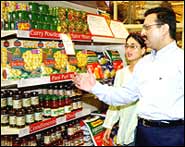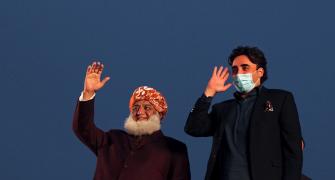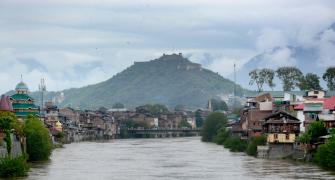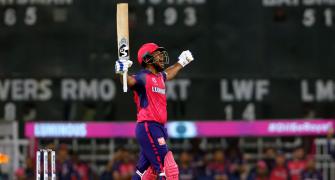
Retail is the new mantra.
Every big businessman is looking at this sector, hoping to catch some of the spending by India's growing middle class.
An early entrant into the retail sector was RPG Enterprises, which began by buying well-known retail outlets in Chennai. In February, the group set up its second Giant Hypermarket in Goregaon, Mumbai.
Raghu Pillai, CEO, RPG Retail, spoke about the company's plans in an interview with Deputy Managing Editor Amberish K Diwanji.
Tell us something about yourself, your background.
I have been working with the RPG group for 23 years, I have been involved in a variety of sectors such as IT, entertainment and lately retail. I moved to retail in 1995, when it was just being started and I have been associated with it since then. I have two children like any regular guy! I am from Kerala but I have lived basically in Mumbai and Delhi. I am currently based in Chennai.
And you work for a Kolkata headquartered firm. Does this pan-India perspective help?
In a sense, it does, but then retail is a very localised business. We started in the south and just opened our chain in Mumbai.
What is the concept behind a hypermarket? How is it different from a mall? Any reason why RPG chose this segment of retailing?
 A mall is essentially a shopping center; a large space where a variety of retail formats are housed. There can multiplexes, food courts, shops, etc. Malls tend to have 350,000 square feet area though most of the new ones in India have around 500,000 square feet.
A mall is essentially a shopping center; a large space where a variety of retail formats are housed. There can multiplexes, food courts, shops, etc. Malls tend to have 350,000 square feet area though most of the new ones in India have around 500,000 square feet.
A hypermarket is essentially a large store that essentially caters to buyers, depending on what one is selling which can range from consumer goods to durable goods to general merchandise. Generally hypermarkets tend to focus on food items, which usually accounts for 40 to 50 percent of their sales, and the remaining items for the rest of the sales.
Talking about food, most Indians tend to buy perishable food items on a daily or two-day basis, and which is purchased from the local grocer or store that is next door to the home. Do you see such customers taking the trouble to travel far off to purchase food items on a regular basis?
Your point is well taken. But let me say we expect our core customers to be more or less from the locality, with about 20 minutes time away. We don't expect people to travel long distances. Very clearly, the only way customers will come to your hypermarket rather than visit his local store is if s/he perceives some value in her/his purchases. And we expect customers because of what we call the price clutch value proposition which means that s/he will get food at a significant cheaper price, with the addition of a better ambience, the ability to pick and choose what s/he wants, assured quality, and without the penalties in term of wasting of time, etc.
So you expect to grab a large share of the retail market?
In the next five years, we expect modern retail marketing stores to take anywhere between 15 to 25 percent of the urban retail market. I don't expect modern retail stores to grab a share of the rural market. But some companies like ITC are moving into the rural areas, focusing on the rural malls catering to farmers, where the malls besides offering products also offer services.
We are catering to the top 20 percent of the urban market, earning Rs 100,000 per annum or more and in the main metropolitan cities of India.
There is this huge interest in the retail sector and every major group seems to be into it or planning to enter it. Is this huge interest justified? Will they all survive?
Let us look at the size of this market. It is huge. India's economy is growing at around eight percent of GDP, and urban India is probably growing faster. Also, more people are entering the work force. If you take the consumption of food and household items in the largest 15 cities by households earning Rs 80,000 or more per year, that market is estimated at Rs 75,000 crores (Rs 750 billion) and growing at 8 to 10 percent. So there is room for all. Certainly, there will be change and some people will get hurt, but I don't think the small retailer will get hurt.
So who will get hurt?
I think it is the people in the middle, who are neither big nor small. But at one level, supply of modern retail marketing will create its own demand. And at another level I think we are all participating in a growing market. To give you an example about the size of the markets: the total consumer durable market in India is Rs 22,000 crores (Rs 220 billion), the poultry market is a Rs 30,000 crores (Rs 300 billion ) market. So we are looking at a huge, huge market, and even if organised retail takes 10 percent of this market in 10 or 15 years time, it is around Rs 50,000 crores (Rs 500 billion), maybe Rs 80,000 crores (Rs 800 billion). I don't see too many companies in such a huge market, so clearly there is room for all.
Will we witness the end of the local store or corner grocer, like in the West?
Fifty years down the line, possibly; but that is too far too worry about now. The reality is, like I said, that organised retail will over the next 5 to 10 years focus on the top cities of India, and within that, on the top segments of the population. But even if organised retail grows to Rs 30,000 crores in food alone, which is huge, it will still be looking at just 18 to 20 percent of the market.
What are Giants Hypermarkets' growth plans?
We set up our first store in Hyderabad in June 2000 and we watched it for a year. Now we are confident that our core business model is right, so opened our store in Mumbai a few days back. Our plan over the next 24 months is to open at 12 to 15 more across India so that we have a national footprint. We are also planning a second store in Mumbai, in Thane actually (northeast of Mumbai) and in Hyderabad, two in Kolkata, two in Delhi, Chennai, Vizag, Bangalore.
How do you plan to keep it competitive?
Essentially, organised retailing is all about leveraging the supply chain in a commercially viable way. The idea is to get as close to the production source as possible once we achieve volumes to keep the costs lower and pass on the benefit to the customer.
How do you plan to fund your expansion plans?
We belong to a large group so a significant amount of the resources will come from the group, we could look at a mixture of some debt. But we are not ruling out the option of some strategic or private investor or also looking external funding. But I don't see any IPO until we reach a certain size, which won't be in the next 24 months.
What about competition, both Indian and foreign? Do you see foreign retailers coming in?
As far as competition is concerned, I am of the firm view that in the initial stages, we need more players in the market to help the market grow. Now we need more players to grab more of the entire market share. The point where different players cut into each others' share is too far into the future, perhaps 10 years away. Right now we still need more players.
We know some big houses are looking at it, such as the Tatas. This business requires huge capital for investment, has long gestation periods, high volumes and low margins, so it is a business that requires some scaling.
Which means it is limited to the big players?
One must have the right idea also. Today, funds for investment are not a problem, what is needed is the right idea and business model and executing them properly to succeed.
Regarding foreign competition, I am sure that they will come in once our laws allow it. At present our laws bar foreign retailers, but there is already huge pressure on the government to open up. I am sure that at some point, the government will have to allow in the foreign players. And the foreign players are keen to come in; their markets have completely saturated and they are all excited by India's huge growth.
Is shoplifting a major problem in India?
Shoplifting, or shrinkage as we call it, is a global phenomenon. Even the world's largest retailer, Wal Mart, with a turnover of $240 billion, suffers a shrinkage of 0.6 percent, which works out to more than $1 billion! But that is the way it is. And shrinkage is clearly focused at lifestyle products.
We try to prevent it by putting a system and procedures in place. And you do so keeping in mind the environment that we operate in, where everything is kept open and displayed. One can make shrinkage zero by keeping everything locked up, or having security guards all over the place, but the cost of doing that is much higher that the 0.5 to 0.6 percent that one suffers on average. So we budget for that and keep a system in place to ensure that the shrinkage percentage is kept low.
Have you seen any difference in the customers across India?
Much of RPG's retail experience has been in the south so it will take some time to actually answer that question. But one thing that clearly stands out in Mumbai is what we call the heavy queuing on weekends. Unlike other cities where the weekday crowds are marginally smaller than weekend crowds, in Mumbai there is no little connection. The weekend crowd surges as much as 10 times compared to the weekday crowds, clearly showing Mumbai's every busy and hectic lifestyle over weekdays. So there is tremendous pressure on our resources on weekends, and we have to deal with that.
But besides that, while the needs are local, customers all over the world are just the same.
Photograph of RPG Vice-Chairman Sanjeev Goenka and Bollywood star Kareena Kapoor: ROB ELLIOTT/AFP/Getty Images
Image: Uday Kuckian







